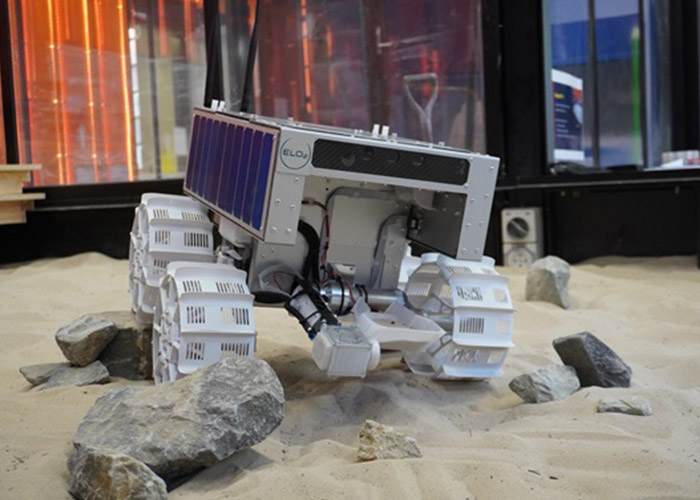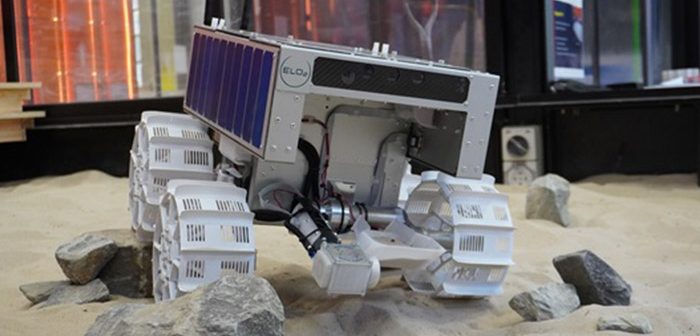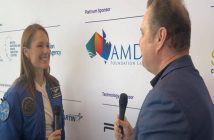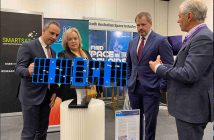
In a ground-breaking moment for Australian space exploration, Adelaide will host the unveiling of the ELO2 Consortium’s pioneering lunar rover prototype, demonstrating Australia’s potential to support a future NASA Artemis mission to the Moon.
The working rover showcases Australia’s expertise in mining and robotics in extreme environments.
It is designed to collect and transport lunar regolith (Moon soil) to a NASA-run facility on the Moon, where oxygen will be extracted to prove technology essential for a sustainable human presence on the Moon, and production of rocket fuel to support a future mission to Mars.
The ELO2 rover prototype will traverse both a lunar and Martian-like surface in Adelaide through Lunar Outpost’s lunar mission ready Stargate remote operations software, in an end-to-end remote operation demonstration.
The display will highlight the collaboration and expertise of ELO2 Consortium partners from Australia’s universities and industry who designed, built and tested this working rover, in just three months.
The ELO2 Consortium is one of two Australian consortia working on the design with funding from the Australian Space Agency’s Moon to Mars Trailblazer Program Stage 1 with an ambition to land a rover, to be named Roo-ver, on the Moon as part of a future NASA Artemis mission later this decade.
The ELO2 Consortium is a national mission co-led by EPE Oceania and Lunar Outpost Oceania. Consortium partners from across the nation have collaborated to build an Australian Made rover:
- Lunar Outpost Oceania spearheaded the design and integration efforts out of its Melbourne office, with RMIT University’s Space Industry Hub and Advanced Manufacturing Precinct manufacturing the rover structure.
- Queensland-based EPE and The University of Adelaide are responsible for ongoing testing and evaluation of the rover.
- Inovor, based in Adelaide, provided the electrical power system, while Melbourne startup Element Robotics contributed to capability and autonomy systems.
- The University of Melbourne’s Space Laboratory conducted thermal analysis, with systems engineering support from Northrop Grumman Australia.
- BHP provided expertise in excavation, while The Australian National University Institute for Space (InSpace) supported the communications subsystems development.
- VIPAC will conduct various flight qualification tests at facilities across Australia and Titomic, also based in Melbourne, will provide speciality flight part manufacturing if the ELO2 design is selected for Stage 2.
This cross-disciplinary teaming arrangement directly supports the Australian Space Agency’s goals of creating skilled jobs, increasing national space capability, forming key partnerships, and inspiring a future workforce to join the space sector in Australia.
“We chose the Australian Rover Challenge in Adelaide to demonstrate the new Trailblazer rover’s capability, and to share the excitement of what’s possible for university students in Australia,” said ELO2 Technical Director with Lunar Outpost Oceania, Joseph Kenrick.
“Over the course of four days, students from universities across the country will learn how to rapidly design, build, and test rovers with functions similar to what will be required on the Moon.”
“A vast majority of the ELO2 engineering team has been hired from former rover challenge teams. Our sponsorship of the Australian Rover Challenge this year is not only an excellent opportunity to meet potential future engineers for ELO2, but to invest in the continued development of students to grow the Australian space and robotics sector.”
ELO2 delivered an initial rover prototype in December 2023, an early feat for this type of program. Just three months later the consortium is unveiling a new, more capable working prototype, showcasing its ability to iteratively design, build, and test at an unmatched pace that provides the most effective means for de-risking what will be Australia’s flagship space mission.
“In developing a lunar rover for Australia, ELO2 has supported over 40 new jobs, including interns, and expects to support more than 150 new jobs if awarded the next phase of the Moon to Mars Trailblazer Program,” said ELO2 Consortium Director from EPE Oceania, Ben Sorensen. He said
“ELO2’s work is developing critical technologies essential to support the productivity and competitiveness of Australian industries and our collaboration with international partners.”
Inspiring Australians is an important aspect of the ELO2 Consortium’s activities. “During the last 12 months we engaged Australian students and engineers in two open innovation design challenges and visited numerous schools and community events to talk about Space and STEM, showcasing our earlier prototype. ELO2 Consortium partner, One Giant Leap Australia, has travelled across the country running Outreach programs to inspire and teach the next generation of Australian innovators. We have also worked with the Endeavour Foundation to involve people with intellectual and cognitive challenges in parts of the design process.” said Ben.
As part of the testing phases, the ELO2 rover will travel across Australia over the coming months to various test facilities and will be making appearances around its testing schedule to engage the public, offering insights into the advancements, challenges and discoveries on the path toward Australia’s lunar exploration milestone.
The first stop is Adelaide, where the rover will be tested over the rocky terrain of a simulated Martian crater and landscape with seven different geological zones at the unique Hamilton Space School in Mitchell Park, Adelaide. Secondary students from Hamilton Space School will see the one-of-a-kind working model of the lunar rover through the eyes of an astronaut as they are suited up to watch the rover drive over the Mars surface.





